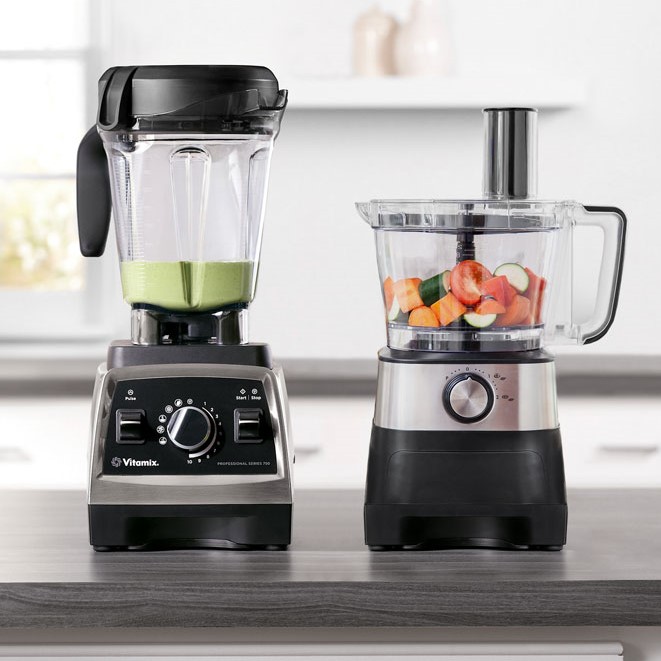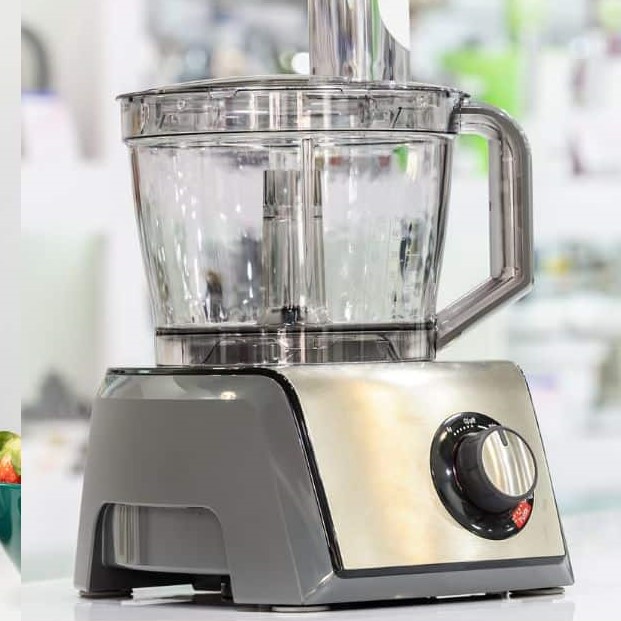
Introduction to Food Processors and Blenders
Food processors and blenders are essential kitchen tools. They help save time and enhance kitchen creativity. However, they serve different purposes and are suitable for varied tasks. This introductory section will explain these tools’ basic functionality and roles in a modern kitchen. Understanding these devices will help you optimize your cooking and preparation tasks effectively.
Food processors are versatile. They excel in tasks like chopping, slicing, and kneading. These tools handle solid foods well, making them ideal for meal prep.
Blenders, on the other hand, are the go-to for liquid recipes. They work best for making smoothies, purees, and soups. Their design is perfect for combining ingredients into smooth, flowing mixtures.
Both these appliances can vastly enhance efficiency in the kitchen. They simplify processes that traditionally take more time and effort. By the end of this section, you’ll have a clearer view of how each can benefit your cooking routine.
Key Differences Between Blenders and Food Processors
The Design and Structure
Blenders and food processors differ in design. Blenders have a tall, narrow jar, ideal for liquids. Meanwhile, food processors feature a wide bowl, perfect for solids. This design impacts how they blend or chop food. A blender’s shape creates a vortex that pulls ingredients down to the blade, ensuring smooth results. On the other hand, a food processor’s bowl allows for easy mixing and handling of bulkier items.
Primary Functions and Performance
Performance varies between blenders and food processors. Blenders excel with liquids, making smooth concoctions like soups or smoothies. Food processors are multifaceted, handling solid foods for chopping, slicing, and more. They enable thorough mixing and preparation without needing to add liquids, unlike blenders.
Attachments and Versatility
Considering attachments, food processors come out on top. They often come with various blades and discs for tasks like shredding and kneading. This makes them more adaptable. Blenders typically have fixed blades. While effective for blending, they have limited versatility compared to food processors. This difference affects the range of tasks each appliance can perform efficiently.
When to Use a Blender
Choosing when to use a blender over a food processor depends largely on the task at hand. Blenders are excellent for tasks involving liquids or when a smooth consistency is desired. Below are some specific instances when opting for a blender might be your best bet.
Making Smoothies and Liquid Mixtures
Blenders shine when it comes to creating smoothies and similar liquid mixtures. Their design helps combine ingredients smoothly and quickly. Just toss in your fruits, some yogurt or juice, and you’re good to go. The blender’s powerful blades liquefy ingredients efficiently, perfect for breakfast smoothies or nutritious shakes.
Crushing Ice and Preparing Drinks
Need to crush ice for cocktails or iced coffee? A blender is ideal. Its sturdy blades and strong motor handle the hard consistency of ice without a fuss. This capability also makes blenders perfect for preparing frozen drinks or desserts quickly and easily.
Puréeing Ingredients for Sauces and Soups
Blenders are also great for puréeing ingredients for sauces and soups. They ensure the texture is smooth and uniform, which is essential for velvety sauces and creamy soups. Just add your cooked vegetables and stock, then blend away to achieve the perfect consistency.
When to Use a Food Processor
Food processors are highly effective for various kitchen tasks. With powerful motors and multiple attachments, they handle tough ingredients with ease. Here’s when you should opt for a food processor over a blender.
Chopping and Slicing Vegetables
Food processors excel at reducing prep time for vegetables. Simply fit the slicing or chopping blade, and it will deliver consistent cuts quickly. Ideal for salads or stir-fries.
Preparing Doughs and Pastries
Mix and knead dough quickly with a food processor. Use the dough blade for bread, pizzas, and pastries. This saves time and effort compared to manual kneading.
Making Chunky Dips and Spreads
Create chunky, textured dips like salsa or thick spreads such as p?té using a food processor. Its blades coarsely chop ingredients, preserving the desired chunky texture.
Comparing Power and Capacity
When choosing between a blender and a food processor, consider their power and capacity.
Motor Strength and Speed Settings
Blenders and food processors have motors of varying strengths.
Blenders typically feature powerful motors that spin at high speeds. This is perfect for smooth liquids.
Food processors have strong motors too, but with more speed options. These speeds help in precise chopping and slicing.
Work Bowl Sizes for Different Needs
The capacity of the work bowl also varies between the two.
Blenders usually have tall, narrow jars. These work well for small to medium quantities.
Food processors come with wider, larger bowls. They are better for large batches or bulky foods.
Consider the amount of food you usually prepare when deciding on the bowl size.
Advantages and Limitations
Benefits of Owning a Blender
Owning a blender offers several benefits for the home kitchen. First, it’s ideal for making smooth, liquid concoctions such as protein shakes, fruit smoothies, and creamy soups. With a blender in your kitchen, you can easily crush ice, making it perfect for cold drinks and smoothies. It is also efficient for creating purees for sauces, soups, and baby food with a silky texture. Blenders are simple to use, generally have fewer parts to clean, and can be an excellent tool for health-conscious individuals who enjoy liquid nutrition like smoothies.
Benefits of Owning a Food Processor
Food processors come with their own set of advantages. They are multipurpose tools designed to tackle solid food prep tasks effectively. Unlike blenders, food processors can chop, slice, and dice vegetables quickly and uniformly. They are excellent for making doughs and pastries, alleviating the effort of manual kneading. For those who enjoy hearty, textured spreads and dips, food processors make creating salsas and nut butters easy. Additionally, with various attachments, these appliances are incredibly versatile and can handle a broad range of cooking tasks.
Considerations for Selecting the Right Appliance for Your Kitchen
When choosing between a blender and a food processor, consider your most common kitchen tasks. If you frequently make drinks, smoothies, or pureed soups, a blender may be your best choice. For more heavy-duty tasks like chopping veggies, preparing dough, or making chunky dips, opt for a food processor. Think about the quantity of food you prepare, as this will impact your decision on the size and power of the appliance. Finally, assess your kitchen space to determine if you can accommodate one or both appliances. Selecting the right tool will ensure efficiency, ease, and enjoyment in your culinary endeavors.
Practical Recipes and Uses
Transform your kitchen work with these easy and practical recipes tailored for blenders and food processors. Discover how best to utilize each appliance with unique and creative dishes.
Unique Recipes for Blenders
Make the most of your blender with these simple yet delightful recipes:
- Berry Protein Smoothie – Combine frozen berries, protein powder, and almond milk for a quick energy boost.
- Chilled Cucumber Soup – Blend fresh cucumbers with yogurt and herbs for a refreshing summer dish.
- Nutty Chocolate Milkshake – Mix ice cream, milk, and a spoonful of peanut butter for a decadent treat.
- Salsa Verde – Puree tomatillos, jalapeno, and onion for a zesty sauce perfect with chips.
- Pumpkin Spice Smoothie – Blend pumpkin puree, banana, spices, and milk for an autumnal delicacy.
Creative Recipes for Food Processors
Put your food processor to good use with these innovative recipes:
- Cauliflower ‘Rice’ – Pulse cauliflower florets until they resemble rice grains for a low-carb staple.
- Homemade Peanut Butter – Grind peanuts until creamy for a homemade spread sans additives.
- Flaky Pie Crust – Combine flour, butter, and water for an effortless pie base.
- Pesto Dip – Blend basil, pine nuts, and parmesan cheese for a classic Italian dip.
- Chickpea Falafel – Process chickpeas with herbs and spices for a tasty vegetarian option.
These are just starting points to inspire your culinary adventures using a blender or food processor. Both appliances offer a world of possibilities for those who love to cook and create.
Conclusion and Recommendations
Recap of Key Points
In this comprehensive discussion on blenders and food processors, we’ve examined their design, functions, and various uses. Here’s a quick recap:
- Blenders are ideal for smooth liquid recipes like smoothies, soups, and drinks. They use a tall, narrow jar and fixed blades to create smooth mixtures.
- Food processors handle solid foods with prowess, suitable for chopping, slicing, and kneading with various attachments for diverse tasks.
- The choice between the two depends on your kitchen tasks. Blenders excel in liquid tasks, while food processors are better for solid food preparations.
Understanding these differences ensures you can choose the right appliance to suit your kitchen needs more efficiently.
 Final Thoughts on Choosing the Right Appliance
Final Thoughts on Choosing the Right Appliance
Choosing between a blender and a food processor depends largely on your usual kitchen activities. If your cooking frequently involves smoothies or liquid dishes, a blender is likely more useful. In contrast, if you often prepare meals that require slicing or dough making, then a food processor will serve you better.
Consider what you cook regularly and select the appliance that will enhance your efficiency in the kitchen. By aligning the appliance with your cooking needs, you ensure a more enjoyable and smoother cooking experience.
Both blenders and food processors are valuable additions to any kitchen, each offering distinct benefits to enhance your cooking and preparation capabilities.

